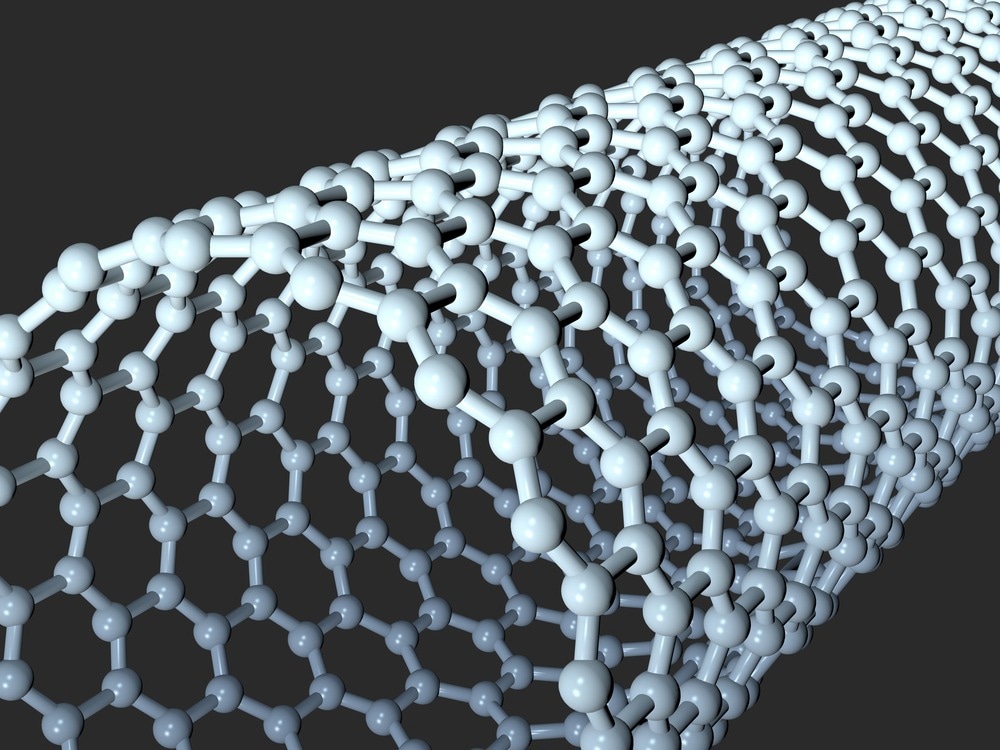Carbon nanotube (CNT) yarn is highly coveted in the smart textiles industry and multifunctional composites because of its light weight and versatility. However, its production is quite challenging due to the loose packaging of carbon nanotubes inside the CNT arrangements.

Study: Microstructural Tuning of Twisted Carbon Nanotube Yarns through the Wet-Compression Process: Implications for Multifunctional Textiles. Image Credit: Promotive/Shutterstock.com
A study published in the journal ACS Applied Nano Materials reported the successful completion of the densification of carbon nanotube yarn via wet compression using acetone, yielding excellent mechanical qualities and remarkable Ohmic heating properties.
What is Carbon Nanotube Yarn?
Researchers have recently focused on providing numerous sophisticated functionalities to smart textiles using carbon nanotubes.
Carbon nanotube filaments are formed by the tight packing and alignment of carbon nanotubes. Tens or hundreds of parallel carbon nanotube filaments can be assembled to generate macro-level carbon nanotube yarn with excellent tensile strength, elastic modulus, and thermal and electrical conduction.
On the other hand, structural limitations, including high porosity and loose packaging found in carbon nanotube assemblies, lead to inferior electro-mechanical behavior of carbon nanotube assemblies as opposed to individual carbon nanotubes.
Challenges in Obtaining Properties of Individual CNTs on a Macro Level
Different techniques such as tension induction and annealing, twisting, solvent or polymer infiltration, and capillary densification have been explored to reproduce the excellent individual carbon nanotube qualities on a macro scale. These techniques use the principle of improving the transfer of load among carbon nanotube bundles by raising the overall van der Waals forces.
While these efforts were successful in increasing the strength of carbon nanotube yarn, they were either restricted to a critical level of twist or compromised due to the transformation of the initial cylinder shape of CNT yarn into a ribbon-like form with crushes and faults in the surface morphology.
Polymeric infiltration improves mechanical and strain-gauging qualities by increasing load transfer among carbon nanotubes. However, successful penetration inside a carbon nanotube assembly is quite challenging without compromising elasticity and conductance because of the insulating behavior of the polymer.
Enhancing the Qualities of Macroscopic Carbon Nanotube Yarn
Physical densification is an effective and facile way to enhance load transmission among carbon nanotube bundles by increasing the van der Waal forces and closing the gap among macroscopic carbon nanotube yarn as well as individual carbon nanotubes.
This approach has been utilized by either using rollers to press carbon nanotube yarn or by drawing the CNT yarn over a number of diamond wire-dies. This approach resulted in carbon nanotube yarn with excellent tensile strengths; however, the small diameter of the ribbon structure restricted their applications in the textile industry.
Carbon nanotubes' high elastic modulus and stored repulsive force help carbon nanotube assemblies like CNT yarn quickly recover from deformations. Therefore, a tightly packed arrangement can only be obtained with the help of an external force.
Why Use Acetone?
Acetone is an organic solvent having reduced surface tension. The superior wettability and strong affinity to carbon nanotube yarn make acetone an ideal choice for minimizing inter-CNT interactions.
Acetone quickly seeps through the carbon nanotube filaments, occupying interior spaces and holes among the carbon nanotube bundles and functioning as a lubricating agent. Therefore, the wetted individual carbon nanotubes inside the CNT yarn can be easily slipped, reorganized, and compressed with enhanced axial alignment during compressing and stretching functions.
Findings of the Study
The team developed a twisted carbon nanotube yarn in this study for textile applications. They used a facile densification process by concurrently compressing and tensioning the CNT yarn under the influence of acetone.
The densified arrangement of the carbon nanotube bundles inside the acetone-infiltrated carbon nanotube yarn increased elastic modulus and tensile strength by 887.5 and 185 percent, respectively. Large diameters of the developed carbon nanotube yarn made it appropriate for it to be used commercially in textile applications.
Lubricating with acetone during the pressing of twisted carbon nanotube yarn represented a key advancement in the electrical, mechanical, and sensory performance of carbon nanotube yarn in comparison with the pressing approach.
Moreover, the remarkable Ohmic heating capability of the developed carbon nanotube yarn at a voltage of just 3 volts demonstrated its promise for use in wearable therapeutic devices and textile goods.
Reference
Farha, F. I., Wei, X., Zhang, Q., Liu, W., Chen, W., Liu, L., & Xu, F. (2022). Microstructural Tuning of Twisted Carbon Nanotube Yarns through the Wet-Compression Process: Implications for Multifunctional Textiles. ACS Applied Nano Materials. Available at: https://pubs.acs.org/doi/10.1021/acsanm.2c02257
Disclaimer: The views expressed here are those of the author expressed in their private capacity and do not necessarily represent the views of AZoM.com Limited T/A AZoNetwork the owner and operator of this website. This disclaimer forms part of the Terms and conditions of use of this website.